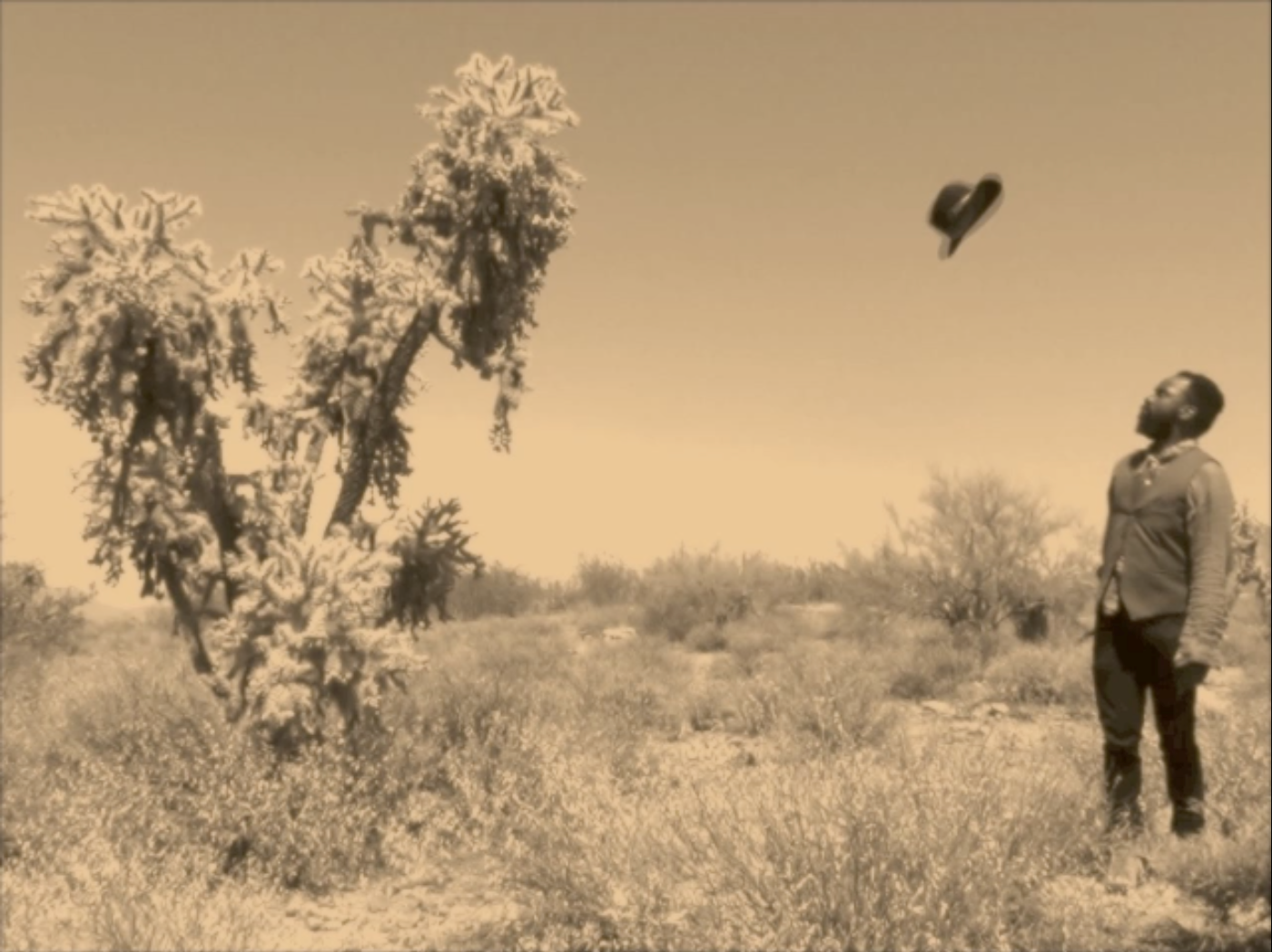
A few metres away from a tree in the breezeless Arizona desert, we see the hat fly. A man has thrown his black fedora hat up and away from his body with his right hand, which falls as his left hand rises to catch it. But just as both arms reach shoulder height, the scene cuts. The hat juggler now stands with his arms to the side, his back straight, and looks up at his hat as it falls, turns – and then rises. For the next twenty seconds, we watch the man watching his levitating hat.
‘Moses’, in white italic font on a black background, is the first frame of Samson Kambalu’s Moses (Burning Bush) (2015). The Contemporary Art Society acquired the film for Bury Art Museum in 2020. On a recent visit, I saw how the Museum’s curators had displayed the work as part of a series of landscapes, including J. M. W. Turner’s Calais Sands at Low Water, Poissards Collecting Bait (1830), to encourage us to rethink how artists have represented the British landscape. According to the Society, ‘Kambalu embraces the subversive potential of non-productive time, the gift economy and the notion of playing.’ The film embodies all these ideas, but it also offers us even more. In an unpopulated landscape, the man remains immersed in watching his hat. The film suggests that he is autotelic: he has purpose in himself, expressed through the hat-throwing that he does for its own sake. In the film’s looping, repetitive style, the hat juggler seems to exist outside linear time. Time and place may change; autotelic action can endure.
Is the hat juggler Moses, and is the tree that stands in the centre of the frame – almost a hatstand – the burning bush? According to Exodus 3:1-17, Moses was tending a flock in the desert when God appeared to him in the flames of a bush that was not consumed by the fire. God ordered Moses to remove his shoes because he was on holy ground and then told him that he would lead the people of Israel away from their oppression in Egypt. Like the biblical Moses, Kambalu’s Moses removes a piece of clothing while standing in the desert. But unlike the prophet, the man’s hat itself becomes the object of worship for the brief time we spend with him.
When I first saw Moses, I thought that he too might need salvation. At times, the black hat hangs so close to the tree. In one frame, the tree looks like a piece of furniture; in another, a witness; in another, a looming threat. If Moses’s head were as high as his hat, his feet could not possibly reach the ground. The sepia palette and high contrast on the tree’s fuzzy leaves make each frame look like a photographic postcard from the Southern United States in the early twentieth century. ‘Southern trees bear a strange fruit / Blood on the leaves and blood at the root.’ When Abel Meeropol wrote these words about lynching and Billie Holiday sang them, thousands of Black people had been killed by racist mobs across the South. Many lynching participants bought black-and-white photos of such murders as mementoes for their friends and family. Although Arizona had no recorded lynchings, it had been a proslavery Confederate territory in the American Civil War. But in the film, soon after the first scene change creates the hat’s gravity-defying flight, the spectre of threat is broken. The filter changes from sepia to X-ray to sepia again, as though our gaze helps to construct the hat’s miraculous levitation.
The last we see of Moses is another X-ray vision, as the film increases in speed, making the hat suddenly jump up, down, and up again. Then it cuts. As I stood in the Museum waiting for the film to restart, my abiding impression of Moses was of the autotelic play and self-care that infused his every gesture and look. In a world where so many of us are committed to obeying the demands of work time, the elusive autotelic action conveyed by an airborne hat represents not a strange fruit but rather a fruitful strangeness.
Jake Subryan Richards
October 2022
Acknowledgements
My thanks to Sria Chatterjee, Gina Warburton, Matt Turner, Naomi Carlisle, Becca Voelcker, Andrea Richards, Ian Richards, and Molly Richards for their feedback.




